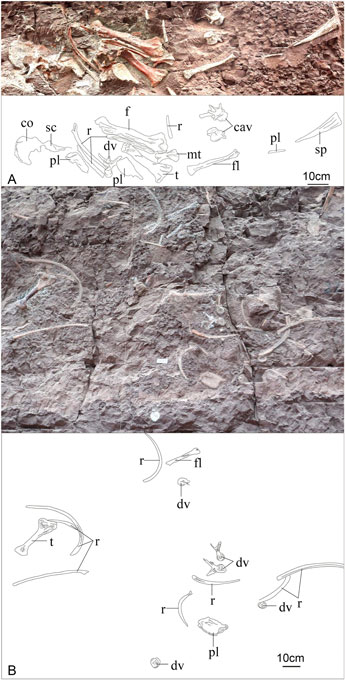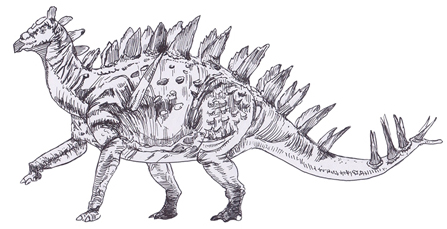Is Bashanosaurus the Oldest Stegosaur? A New Dinosaur Taxon
The trouble with being regarded as the biggest, longest, tallest or oldest when you are newly described species of dinosaur, is that sooner or later another fossil discovery will take this claim away from you. Back in 2019, team members wrote a blog post about the discovery of Adratiklit boulahfa from the Middle Jurassic of Morocco North Africa’s First Stegosaur. The fossils of this armoured dinosaur were estimated to be around 168 million years old (Bathonian faunal stage), making Adratiklit the oldest definitive stegosaur described.
Scientists including Dr Susannah Maidment a senior researcher at the London Natural History Museum, who co-authored the paper describing A. boulahfa, have announced the discovery of an even older stegosaur, this time from China. The new stegosaur named Bashanosaurus primitivus is at least one million years older than the Moroccan stegosaur.
The Fossils of Bashanosaurus
The fossils of Bashanosaurus herald from the Lower Member of the Shaximiao Formation and radiometric dating based on isotope decay analysis using zircon crystals (geochronological data), suggest that the deposits associated with the fossil bones are around 169 ± 0.68 million years of age.

A life reconstruction of the newly described Chinese stegosaur Bashanosaurus primitivus. Picture credit: Banana Art Studio.
Picture credit: Banana Art Studio
Did the Stegosauria Evolve in Asia?
The fossil record of early stegosaurs is highly fragmentary and the evolution of this iconic branch of the Thyreophora is poorly understood. The Stegosauria represents a major clade within the Ornithischia (bird-hipped dinosaurs). Fourteen genera of stegosaur have been described to date and they are both geographically and temporally widespread, known from all the major landmasses except for Australia and Antarctica.
In 2016, a new dinosaur quarry was opened in Yunyang County, Chongqinq Municipality in southwestern China. Stegosaur fossil material was identified on the western side of the quarry. The disarticulated material preserved within the sandstone consisted of a dorsal vertebra, two tail bones (caudal vertebrae), a right scapula, a right coracoid and elements from the hind legs. Three pieces of dermal armour were also discovered at this location (one plate and two spines) along with fragments of rib bones. These fossils (CLGPR V00006-1) are regarded as the holotype of B. primitivus.
Potentially Three Bashanosaurus Specimens
More stegosaur fossils were found at the site approximately fifty metres away from the holotype material (CLGPR V00006-2). They consist of five dorsal vertebrae, a right tibia, a right fibula some ribs and a single piece of dermal armour (one plate). In addition, a single dorsal vertebra (CLGPR V00006-3) was found on the eastern part of the site some one hundred and twenty metres away from the holotype material.
Whilst the researchers have confidently assigned these fossils to the Stegosauria and specifically to Bashanosaurus primitivus, three individual stegosaurs are represented by the bones.

Photograph (A) with interpretative line drawing showing the position of the B. primitivus holotype fossil material (CLGPR V00006-1) on the western side of the wall of dinosaur fossils. Photograph (B) with interpretative line drawing showing the second location with B. primitivus fossil material ((CLGPR V00006-2) towards the middle of the wall of dinosaur fossils. Picture credit: Hui et al.
Picture credit: Hui et al
It is not known whether the fossil bones represent a juvenile or a fully-grown animal. However, based on these bones, the researchers estimate that the largest stegosaur from the quarry was about 2.8 metres in length.
Unique Anatomical Traits
The scientists who include researchers from the Chongqing Bureau of Geological and Mineral Resource Exploration and Development in China and London’s Natural History Museum identified several unique anatomical traits that led to the erection of a new genus. Bashanosaurus possesses anatomical characteristics associated with basal thyreophorans as well as more derived features associated with early stegosaurs. For example, it has a smaller and less developed shoulder blade, the bony projection of the thighbone (fourth trochanter) is positioned below the middle of the shaft and the bases of the armour plates curve outwards and are thicker than the plates on the backs of later stegosaurs.
The genus name is derived from “Bashan” in reference to the ancient name for the area of Chongqing in China where the dinosaur was found. The species moniker is derived from the Latin for “first” – primitivus.
Lead author of the research team, Dr Dai Hui from the Chongqing Bureau of Geological and Mineral Resource Exploration and Development commented:
“All these features are clues to the stegosaurs’ place on the dinosaur family tree. Bashanosaurus can be distinguished from other Middle Jurassic stegosaurs, and clearly represents a new species.”
Phylogenetic Analysis
Phylogenetic analysis shows that Bashanosaurus primitivus is the earliest-diverging stegosaur, along with Chungkingosaurus (C. jiangbeiensis), which is thought to be closely related, although Chungkingosaurus lived much later than Bashanosaurus. Chungkingosaurus fossils are known from the Upper Member of the Shaximiao Formation.
The discovery of Bashanosaurus will help researchers to learn more about the evolution of stegosaurs and supports the theory that this type of armoured dinosaur first appeared in Asia. Although there have been some exciting fossil discoveries helping to improve understanding with regards to the evolution of armoured dinosaurs (Thyreophora), there are still numerous gaps in the fossil record which makes mapping the evolutionary development of these iconic dinosaurs extremely difficult.
For example, Everything Dinosaur recently wrote an article about the discovery of the basal thyreophoran Yuxisaurus kopchicki, whose fossils also come from China. Scientists from the London Natural History Museum also contributed to the scientific paper on Yuxisaurus: The Earliest Armoured Dinosaur Found to Date.
Everything Dinosaur has inserted Yuxisaurus kopchicki within the phylogenetic assessment of Bashanosaurus to help put these recent fossil discoveries into context (see below).

A phylogenetic analysis showing the placement of B. primitivus within the Stegosauria. It is believed to be around one million years older than the recently described Adratiklit boulahfa (Maidment et al) from the Middle Jurassic of Morocco. The earliest armoured dinosaur from Asia known to date (Yuxisaurus kopchicki) from Yunnan Province, China (Yao et al) has been incorporated into the image by Everything Dinosaur to show the approximate phylogenetic and temporal placement of Y. kopchicki when compared to B. primitivus. Picture credit: Hui et al with additional annotation by Everything Dinosaur.
Picture credit: Hui et al with additional annotation by Everything Dinosaur
The Stegosauria Clade Originated in Asia?
Commenting on the phylogenetic assessment Dr Hui stated:
“What’s more, our analysis of the family tree indicates that it [B. primitivus] is one of the earliest-diverging stegosaurs along with the Chongqing Lizard (Chungkingosaurus) and Huayangosaurus. These were all unearthed from the Middle to Late Jurassic Shaximiao Formation in China, suggesting that stegosaurs might have originated in Asia”
Picture credit: Everything Dinosaur
The picture (above) shows a drawing of a model from the PNSO model range.
To view this range of prehistoric animal figures: PNSO Age of Dinosaurs Figures.
Co-author of the scientific paper published in the Journal of Vertebrate Paleontology, Dr Susannah Maidment of the London Natural History Museum and an expert in ornithischian dinosaurs added:
“The discovery of this stegosaur from the Middle Jurassic of China adds to an increasing body of evidence that the group evolved in the early Middle Jurassic, or perhaps even in the Early Jurassic, and as such represent some of the earliest known bird-hipped dinosaurs. China seems to have been a hotspot for stegosaur diversity, with numerous species now known from the Middle Jurassic right the way through until the end of the Early Cretaceous period.”
Everything Dinosaur acknowledges the assistance of a media release from the Taylor & Francis Group in the compilation of this article.
The scientific paper: “New Stegosaurs from the Middle Jurassic Lower Member of the Shaximiao Formation of Chongqing, China” by Dai Hui, Li Ning, Susannah C. R. Maidment, Wei Guangbiao, Zhou Yuxuan, Hu Xufeng, Ma Qingyu, Wang Xunqian, Hu Haiqian and Peng Guangzhao published in the Journal of Vertebrate Paleontology.
Visit the Everything Dinosaur website: Everything Dinosaur.


